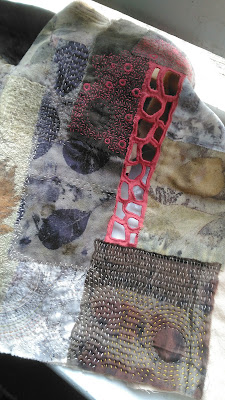Here is a selection of my Cuddle Cloths.
My Mother's Day Bouquet Cloth. Two strips of silk into which I bundled the wilted flowers and leaves. Steamed for half an hour in a semi-used onion skin dyebath. I often have one of those sitting around. Left for a week, opened, rinsed, pressed, sandwiched up with a strip of walnut-dyed silk noil and kantha stitched. I put the last stitches in yesterday and felt sad and satisfied at once. It has no 'purpose'. It is too small for a scarf or shawl, too precious for a table runner, too long for a book wrap, too unassuming (and double-sided) to be hung on the wall. It is a Cuddle Cloth, no more, no less. It gives me pleasure and preserves the precious bunch of flowers from my precious daughter forever. If someone asks 'what is it FOR?', there's my answer.
This is the newest addition to the family. A piece of lichen-inspired embroidery on a scrap of old linen, gifted to me by a friend. This was begun on Friday during a workshop with the sublime Alice Fox where we looked at ways to stitch with found objects. Here are all my loose threads pulled from natural dyed cloths, kept because I can't bear to discard them. In among are some actual scraps of dried, dead lichen. I will not take live lichen (even that growing on dead wood may be alive). It grows too slowly and some is endangered. I am not expert enough to know which is prolific and which is rare so I leave it all and take only photos. But these small wisps were blowing free, completely dead and dried. Little openings in the threads invited holes. That is what I am working on at the moment, the holes. There will doubtless be seeding in the future. Possibly French knots. We will see. This is a Make-It-Up-As-I-Go-Along Cloth. I am enjoying stitching it.
This is my Going in Circles Cloth and with it, some Nine Patches from salvaged denim. For now, they sit together in a basket as if they may belong but they haven't yet been joined by stitch. They are living together first to see if it works out, before they tie the knot. Or not.
The cloth itself needs more work. There are many more ways to make a circle with cloth and stitch to be explored.
My Fallen Leaves Cloth, begun in a day's stitching session with Caroline Bell, who showed me how to make the holes. I examine this daily, it sits over my office chair. I often feel the urge to stitch it but the spaces are nearly all filled and I am not yet ready for the Finish. I am saving it for One Day...
Some Sixteen Patches made from a selection of natural dyed cloths. Just Because Cloths. There are four, there may be more, or not. They may be joined into one big Sixty Four Patch and stitched some more. They are deliciously multi-textured, due to the different weights of cloth (linen, silk noil, old flannel sheet, Osnaburg, wool, recycled cotton shirting). They are also invitingly flat. Hand stitched seams, finger pressed open then stitched down. They create a new checkerboard cloth that invites a second layer for substance and then some more stitch. They are simple things, these four squares of squares, but they hold such Promise. While they wait, and tempt, they are Cuddle Cloths.
These cloths are from my Beach Bundle last February - Ten Turns of the Tide. I want them to become A Piece. To have Importance. Especially since I have recently been alerted to a suitable call to entry with a looming Deadline. But these cloths are mute. They tell me nothing of what they should be. I keep thinking of the ripples the tide makes in the sand. The relentless in and out, twice a day, without fail. But these thoughts won't translate into action. Yet.
If the Deadline is missed, there will be another.


















